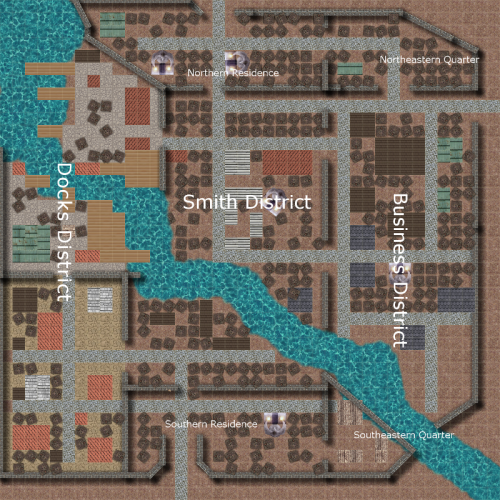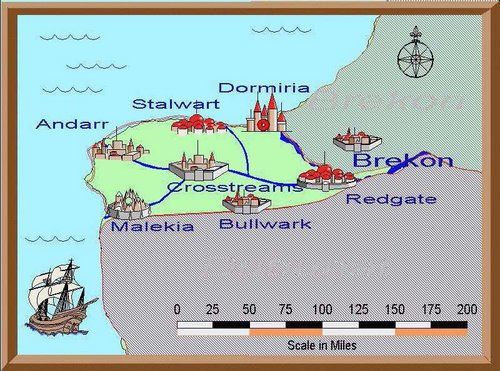Andarr: Difference between revisions
| Line 31: | Line 31: | ||
By the 14th century A.O.D., the human population was in the minority and the noble rulers of the city were gradually displaced by wealthy merchants who wielded more power. This cultural and political shift drew Andarr away from its loyalties to [[Kurathene|The Kurathene Empire]] and the [[Arvanos]] fiefdom. For two centuries, the cities of the area were already governed by a Provincial Council of The Chartered Cities, and in 1363 this council elected to declare its independence from the Empire, conveniently after the Empire was weakened by a recent war with [[Dubunat]] in 1360. Without any alternative choices, the Empire relented and withdrew its garrison from the area, thereby giving the chartered cities their independence. | By the 14th century A.O.D., the human population was in the minority and the noble rulers of the city were gradually displaced by wealthy merchants who wielded more power. This cultural and political shift drew Andarr away from its loyalties to [[Kurathene|The Kurathene Empire]] and the [[Arvanos]] fiefdom. For two centuries, the cities of the area were already governed by a Provincial Council of The Chartered Cities, and in 1363 this council elected to declare its independence from the Empire, conveniently after the Empire was weakened by a recent war with [[Dubunat]] in 1360. Without any alternative choices, the Empire relented and withdrew its garrison from the area, thereby giving the chartered cities their independence. | ||
Unfortunately, unity among the chartered cities did not last. Their squabbling degenerated into skirmishes and the council broke up into completely independent city-states, each responsible for its own defense and well-being. The nation of [[Dubunat]] to the south took advantage of this disunity in 1518 and invaded, nearly conquering the entire realm, but were beaten back once the cities realized they must unite and work together. Later that year, Lord Governor Curtis Allendale of Andarr proposed a confederation of the seven cities for mutual defense and trade. Within six months the treaty was ratified and the [[The Seven Cities|The Confederation of The Seven Cities]] was born. | |||
==Districts== | ==Districts== | ||
Revision as of 00:52, 4 April 2017
| Andarr | |
| Other Names: | Gateway to The Sea |
| Society: | |
| Nation/Territorial Area: | The Seven Cities |
| Population: | 1.5 Million |
| Languages: | Common, Orcish, Romini, Elven |
| Deities Worshipped: | The Nine, and other minor deities |
| General Alignment: | Neutral Good (Neutral) |
| Head of City Government: | Lord Whelan Ferrin |
| Races: | |
| 40% Human, 20% Orc, 20% Elf, 20% Other | |


History
Andarr is the westernmost city of the confederation making up The Seven Cities. This city serves as a major year-round port for virtually the entire western coast of Avlis. While other cities in the confederation, such as Stalwart and Malekia, have ports of their own, only Andarr's is large enough to accommodate the huge amounts of trade going in and out of the region, and only Andarr's port has all the necessary technology for building, repairing, and maintaining ships of all sizes. In the port of Andarr, there are ships from all nations conducting trade. Goods from inland areas come down the Divalok River to the Blackwater River and land in Andarr where they are loaded onto bigger vessels and taken away. Conversely, ships from elsewhere come into Andarr and unload their goods where they are carted up the river to the inland areas. A good portion of these goods are also known to go directly out the northern and southern gates of the city as well. As most citizens will tell you, "Everything stops and starts in Andarr."
Settlement of the land occupied by present-day Andarr began in the 3rd century A.O.D. The deep water and clean access to trade routes by land and sea made the area attractive for new settlers from the north. Not long after the first settlers arrived, the population increased to the point where Emperor Joral Kuras of The Kurathene Empire issued the official city charter dated 317 A.O.D to Lord Arvanos, a prominent noble and close associate of Emperor Kuras.
For the next several centuries, the city grew in size and the lands immediately surrounding it were gifted to or inherited by minor members of the Arvanos family who lacked the seniority to control assets in the main fiefdom up north. Due to the volume of trade goods flowing in their direction, these noble offshoots inevitably became richer than some of their compatriots back home, occasionally causing squabbles within the political framework of the Arvanos lands.
One unforeseen effect of the trade boom in the area was the attraction of settlers from other regions of Negaria. Hopeful merchants from T'Nanshi, Galdos, Deglos, M'Chek, and even as far away as Drotid made successful livings selling goods back to their home countries, and amassed great wealth for themselves. Over time, this wealth enabled them to purchase lands around the city and assets within the city, displacing some of the original Arvanos noble family members who were all human.
By the 14th century A.O.D., the human population was in the minority and the noble rulers of the city were gradually displaced by wealthy merchants who wielded more power. This cultural and political shift drew Andarr away from its loyalties to The Kurathene Empire and the Arvanos fiefdom. For two centuries, the cities of the area were already governed by a Provincial Council of The Chartered Cities, and in 1363 this council elected to declare its independence from the Empire, conveniently after the Empire was weakened by a recent war with Dubunat in 1360. Without any alternative choices, the Empire relented and withdrew its garrison from the area, thereby giving the chartered cities their independence.
Unfortunately, unity among the chartered cities did not last. Their squabbling degenerated into skirmishes and the council broke up into completely independent city-states, each responsible for its own defense and well-being. The nation of Dubunat to the south took advantage of this disunity in 1518 and invaded, nearly conquering the entire realm, but were beaten back once the cities realized they must unite and work together. Later that year, Lord Governor Curtis Allendale of Andarr proposed a confederation of the seven cities for mutual defense and trade. Within six months the treaty was ratified and the The Confederation of The Seven Cities was born.
Districts
Some of the major features of Andarr are that it is bisected by the Valokian River into a northern and southern half, and each of its districts is completely walled in and separate from all the others. The creators of the city felt that this would make it more easily defensible against invaders from the sea who might try to establish a beachhead there. Anyone coming in from the ocean would need to take each district separately as if it were its own tiny little city.
The docks district is one of the larger sections of Andarr. This area is located on the western shore of the city and serves both as a trade depot and a military rally point for all manner of naval activity. The docks district is so big that it stretches from the northernmost tip of Andarr to the southernmost tip. In effect, the entire western piece of the city is made up of docks and dock-related buildings.
Near the center of the city, and immediately east of the docks, is the Smithing District. The other major commodity which Andarr is known for is metal goods. The government of Andarr is a major importer of iron ore, which is fashioned into all manner of metal implements by the smiths in the smithing district. Many know that the dwarves are the best smiths in the land, but the people in Andarr would argue that that's only true if the dwarf is Andarrian. A large portion of the smiths in Andarr are orcish, and there are even some human and elven ones. Truthfully, the smiths of Andarr are of all races, and no matter which race they are, it is generally accepted that their goods are superior to all but the finest from Galdos and Deglos.
To the north and south of the Smithing District are residential areas where the large population of Andarr makes its go at living. The two residential districts, with the Smithing District in between them, are all adjacent to the docks. East of these districts is the largest district of Andarr, the Business District. The bulk of Andarr's economic and governmental activity takes place here. Goods that are brought down by boat are sold in a small market if desired. However, the majority of the space in this district is used by trading companies who conduct imports and exports. The sprawling mass of buildings in this district goes for the entire length of the city from north to south.
East of the business district are two more walled-in sections, one to the north of the river and one to the south. Both are residential in nature, however the one to the south tends to include houses of wealthier families. In the northeastern residential district, there are many taverns and other establishments for fun and pleasure, and the residents of Andarr often refer to this place as the Tavern District, though officially it is still known as the Northeastern Residential District.
As in all seven cities, the population of Andarr is diverse. However, because of Andarr's strategic location, there is a lot of outside influence from other governments. The lords of Andarr are closely tied to various Kurathene nobles, such as the goodly Lord Arvanos, and the much defamed Lord Crullath. It is not uncommon to see ships from the various Kurathene nobles docked at this port. For many, Andarr is the stopping point along the journey to the Kurathene from points south, and it has gained a reputation as a decent place to make business transactions and dealings between multiple parties. For everyone wishing to make their presence known in The Seven Cities, Andarr is one of the best places to start their work. Its central location lends itself to this.